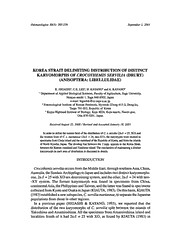
Korea Strait delimiting distribution of distinct karyomorphs of Crocothemis servilia (Drury) (Anisoptera: Libellulidae) PDF
Preview Korea Strait delimiting distribution of distinct karyomorphs of Crocothemis servilia (Drury) (Anisoptera: Libellulidae)
Odonatologica30(3): 265-270 September1, 2001 KoreaStrait delimitingdistributionof distinct karyomorphsofCrocothemisservilia (Drury) (Anisoptera: Libellulidae) K.Higash¹iC.E.Lee H.Kayano³ andA.Kayano³ ², 1 DepartmentofAppliedBiologicalSciences,Faculty ofAgriculture,SagaUniversity, Honjyo-machi1,Saga840-8502,Japan e-mail: [email protected] 2 EntomologicalInstitute ofKorean Peninsula,Hyomok-2Dong615-2, Dong-ku, Taegu701-032,RepublicofKorea 3Kujyu-HighlandInstituteofBiology,Kuju4026,Kuju-machi,Naoiri-gun, Oita878-0201,Japan ReceivedAugust22, 2000/Revised andAccepted January18,2001 Inordertodefinetheeasternlimit ofthedistribution ofC.s.servilia (2nd=25,XO)and thewesternlimitofC. s. mariannae(2nd=24,neo-XY),thekaryotypeswerestudiedin specimensfromChejuisland andthemainland oftheRepublicofKorea,andfromtheislands ofNorth Kyushu,Japan.Thedividinglinebetweenthe2sspp. appearsin theKoreaStrait, betweentheKoreanmainlandandTsushimaisland.Themechanismofmaintainingadistinct karyomorphineachareaofdistributionisdiscussedin details. INTRODUCTION Crocothemisserviliaoccurs fromtheMiddleEast, through southernAsia,China, Australia,theSundaicArchipelago toJapanandincludestwodistinctkaryomorphs: one,2nS =25withXOsex determiningsystem, andthe other,2nd =24withneo- -XY system. The former karyomorph was found in specimens from China, continentalAsia,thePhilippines andTaiwan,andthelatterwasfoundinspecimens collectedfromKyotoandOsakain Japan(KIAUTA, 1983).Onthisbasis, KIAUTA (1983) establishedanewsubspecies, C.serviliamariannae,toseparatetheJapanese populations fromthoseinotherregions. In a previous paper (HIGASHI & KAYANO, 1993), we reported that the distributionofthe two karyomorphs ofC. servilia split betweenthe islands of YakushimaandAmamioshima.Allthespecimens fromAmamioshimaislandand localitiesSouth ofit had 2n<3 =25 with XO, as found by KIAUTA (1983) in 266 K.Higashi,C.E.Lee, H.Kayano&A.Kayano specimens fromTaiwan.AllthosefromYakushimaisland andlocalitiesNorthof it had2nt? =24withneo-XY,as foundby KIAUTA(1983)inspecimens fromKyoto andOsaka, Japan. Taking thestudiesofKIAUTA (1983) andHIGASHI & KAYANO (1993)into account, INOUE & TANI (1999) and SUGIMURA et al. (1999) treated the populations ofC. serviliadistributedover the area fromAmamioshimaisland to southernlocalitiesas C. s. servilia and the onesfromYakushimaisland andthe localities Northofit as C. s.mariannae. Inordertofindtheeastern limitofthedistributionofC.s.serviliaandthewestern limitofC. s. mariannae,we collectedspecimens from localitiesin Cheju island andthemainlandoftheRepublic ofKorea,andfromislandsofNorthKyushu, Japan. The dividing linebetweenthetwo subspecies was foundtolieinthe KoreaStrait betweentheKoreanmainlandandTsushimaisland.Thepresentpaperalsoreports chromosomesof specimens collectedfromThailand. MATERIALANDMETHODS SpecimensofCrocothemisserviliausedforchromosome preparationwerecollected fromthe following localities: (1) REPUBLIC OFKOREA; lij,Kangnung,Kangwondo,13-VII-1994 (specimenNo.Ka-I); —3c?, Yongdok,Kyongsangpukdo, 12-VII-1994(NosYo-1,2&3);— 4c?,Kyongsan,Kyongsangpukdo, 14- -VU-1994(NosKy-1,2, 3 &4); — 3c?,Sogwipo, Chejudo(Cheju-island),5-VII1-I996(NosCh-I, So-1 &2). (2) JAPAN;13c?,Kamiagatachou,Tsushima-island,Nagasakipref. I3-VII-1992(Nos Th-1,2& 3,Sh-1,2, 3,4,5,6,7, 8,9& 10); —3c?,Mitsushimachou inTsushimaisland,Nagasakipref. 14-VII-1992(Nos Mt-1,2&3);—5c?,Gounourachou&Ishidachou,Ikiisland,Nagasakipref., 15-VH-I992(NosDd-1,2, 3,4&5); —4<?,Fukue,FukuejimaislandinGotorettoArchipelago,Nagasakipref.,31-VH-1997(Nos Fu-1,2,3,4&5). (3) THAILAND:2c?,ChiangMai(ChiangMaiUniv.), l-X-!999(NosChn-l&2),8c?,BanBoLuang,30- -IX&1-X-I999(NosBl-1,2,3,4,5,6,7&8). Themaleswerefixedwithaceticalcohol(1:3)immediatelyafterorwithin onedayofcapture.Thespecimens weretransferredto70%ethanolaftertwodaysoffixationorkeptinthefixingsolutionandstoredinarefrigerator. Toobservespermatogonialandprimaryspermatocytechromosomes,testesweredissectedoutin70%ethanol orinthefixingsolution andwerestained for2to3hourswith alcoholic hydrochloricacid-carmine(SNOW, 1953).Each testiswascutintopieces andeachpiecewasmadeintoatemporarysquashpreparationusing45% acetic acid.Afterdissection,thespecimenswerekeptin70%ethanoland storedin arefrigerator. RESULTSAND DISCUSSION Primary spermatocyte complements in specimens from the islands in North Kyushu, Japan(Tsushima, Iki,Fukuejima), showedtwelvebivalents(n = 12)(Fig.l A-C).Thiskaryomorph, withoutan“in”bivalent(see,below),hasaheteromorphic bivalentformedbyneo-Xandneo-Ychromosomes(neo-XY),similartothatshown by KIAUTA (1983)in specimens fromKyoto andOsaka. Thekaryomorph isidentictothatoccurringinallthespecimens fromYakushima Distribution ofkaryomorphsin Crocothemis servilia-complex 267 islandandfromlocalities Northofit(HIGASHI & KAYANO, 1993). The originofthe neo-XY is explicable in terms ofa change from XO. A translocationbetweenthe X and an “m” chromo- some, followedbylossof apart oftheproduct, has given a neo-X chromo- some. Theunpaired “m” hasremainedas aneo-Y (KIAUTA 1983;HIGA- SHI&KAYANO, 1993). On the other hand, specimens from the Republic ofKorea(Cheju island,Kyongsan, Yondo- ku and Kangnung), and thosefromThailand(Ban Bo Luang), showed in primary spermatocytes twelve bivalents and a univalent(n= 13) (Fig.l Fig. 1.Primaryspermatocytechromosomesatdiakinesisormetaphaseof C.serviliafromdifferentlocalities:(A-C)n= 12(<C.s.mariarmae)from D-F). The univalentre- Ddisland (A),Tsushimaisland (B)andFukuejimaislandin Gotoretto presents the X and the Archipelago(C),Japan;—(D-F)n=13(C.s.servilia)fromChejudoisland smallestbivalent,the“m” (D)andYongdok(E), bothKorea, andfromBanBoLuang,Thailand(F). chromosome.Thesexde- termining system is XO. This karyomorph is also foundin all specimens from AmamioshimaislandandfromlocalitiesSouthofit(HIGASHI&KAYANO, 1993). Itis identictothatreportedby KIAUTA (1983)inspecimens fromcontinentalAsia, China,thePhilippines andTaiwan. From the present and earlier investigations (KIAUTA, 1983; HIGASHI & KAYANO, 1993),itisunequivocal thatC.serviliamariannaeisendemictoJapan; in the South its distributionrangereaches Yakushimaisland, wherethe western borderisrepresented byTsushimaislandandtheGotorettoArchipelago. (C.s.servilia occurs SouthofAmamioshimaisland.Theeastern limitofits distributionis Cheju islandandmainlandoftheRepublic ofKorea(Fig. 2 A,B). Itwouldbeinteresting toascertainthe subspecific identity ofthepopulations in theTokararettoArchipelago,connecting theAmamioshimaandYakushimaislands. Oneof thepresent authors(K.H.), triedto collectC. servilia ontheislandsofthe 268 K.Higashi,C.E.Lee, H.Kayano&A.Kayano Fig. 2.Distribution ofCrocothemis serviliakaryomorphs:(A)Korea and theislandsNorthofKyushu, Japan; — (B)Kyushu andtheJapanesesouthwesternislands. — [Dots indicate collectingsites] TokararettoArchipelago, i.e.onKuchinoshimaand Takarajima, inmidJuly 1998, and onKuchinoshima, Nakanoshima, Akusekijima and Takarajima, in mid July 1999.Unfortunately, thespecies was not foundon any ofthese. ItisconceivablethatC. s. serviliaindividualscouldmigrateintotheareaofC.s. mariannae,and vice versa. Themechanismtomaintaina distinctkaryomorph in eachareaofdistributionis discussedbelow. Wemustfirst considerthepossibilityofhybridizationbetweenthetwo subspecies. Here,thekaryomorph ofC. s.mariannaeisdenotedby 2n? =24(22+neo-X+neo- -X) and 2n<? = 24 (22+neo-X+neo-Y) and that of C. s. servilia. 2nV = 26 (22+m+m+X+X) and2nd=25(22+w+m+X). Inthecaseofhybridizationbetween C. s. servilia (9)and C. s. mariannae(<?),Fl’s are2n? = 25(22+w+X+neo-X) and2nd =25(22+/n+neo-Y+X)whichissubstantially22+m+m+Xandequivalent to themaleofC. s.servilia(Tab. I, A). Hybridization betweenC. s. mariannae(?) andC. s. servilia(c?) willproduce Fl’s consisting of2n9 =25(22+w+X+neo-X)and2nc? =24(22+w+neo-X)which is substantially 22+neo-Y+neo-Xandequivalent to the maleof C. s. mariannae DistributionofkaryomorphsinCrocothemis servi/ia-complex 269 (Tab.I, B). TheFl females,2n9 =25(22+m+X+neo-X) are partially sterile,because dueto randomsegregationofthemchromosomein meiosis, onehalfoftheeggs arenot functional.TheFl femaleswillgive fourkinds ofgametes; (1) n= 12(11+neo-X), (2) n = 13(11+m+X), (3) n = 13(11+m+neo-X) (excess of “m”),and (4) n = 12 (11+X)(shortnessof“m”).Among these,types (1)and(2)aregenetically balanced (functional in fertilization),but types(3) and(4) are genetically unbalanced(not functional). Secondweconsiderhowforeign chromosomalelementsbehaveafterthehybrid femalesrepeatedlyback-cross to member(s)ofthesurrounding “native”population. As mentionedabove, the Fl femalesarepartially sterile, irrespective ofdirection ofcrosses betweenthetwo subspecies. Inthecaseof thesurrounding population being C. s. mariannae,females intheoffspring areoftwo kinds, onehalfis C. s. mariannaeand another half, hybrid type (Tab. II). Inthemales ofback-crossed offspring, one halfis C. s. mariannaeand anotherhalf, C. s. servilia. In each generation ofthe offspring afterimmigration, thetheoreticalrate of C. s. servilia males and hybrid typefemalesdecreasetohalfoftheprevious generation. IncasesofthehybridsbeingsurroundedbymembersofC. s.servilia(immigration ofC. s.mariannaeintoapopulationofC.s. servila),back-crosses willgiveoffspring in whichonehalfofthefemalesis hybridtypeandtheotherhalfis C. s. servilia (Tab. II). Inmalesoftheback-crossedoffspring, onehalfis C. s. servilia andthe otherisC. s.mariannae.Theoretically,therateofC.s. mariannaemalesandhybrid typefemalesdecrease tohalfofthe previous generation. Therefore, as long as the immigrants arerare in thepopulation, itis likely that the foreign karyomorph introducedby the immigrants will disappear from the population in a few generations. In fact, exchange ofindividualsbetween the populations ofdifferentkaryomorphs is veryrestrictedbecausethetwo karyomorphs are distributed in differentareas, separated by the sea over a long distance. Table! Presumptivechromosomeconstitutions ofhybrids(Ft)resultingfrom crossesbetween twosubspecies ofC. servilia;inFl males“m+neo-Y”isequivalentto“m+m”andunpaired“m”issubstantially“neo-Y” ((AA)) CC..ss..mmaarriiaanrmnaaee((<<5?))x*(CC..ss..sseerrvviilliiaa((2$)) SSppeerrmm EEggggnn==1133((1111++mm++XX)) nn==1122((1111++nneeoo--XX)) ((22nnS9==2255))2222++mm++XX++nneeoo--XX hhyybbrriiddttyyppee nn== 1122((1Il1++nneeoo--YY)) ((22nn<c?J==2255)) 2222++mm++nneeoo--YY++XXsseerrvviilliiaa ttyyppee ((BB))CC..ss..sseerrvviilliiaa((dcJ))xxCC.is.mmaarriiaarnmnaaee((2$)) SSppeerrmm EEggggnn==1122((1111++nneeoo--XX)) nn==1133((1111++mm++XX)) ((22nn52 ==2255))2222++mm++XX++nneeoo--XX hhyybbrriiddttyyppee nn==1122((1111++mm)) ((22nnJd==2244))2222++mm++nneeoo--XXmmaarriiaarnmnaaeettyyppee 270 K.Higashi,C.E.Lee, H.Kayano&A.Kayano TableII Presumptivechromosomeconstitutionsexpectedinoffspringresultingfromback-crosses betweenfemalesof FIhybridfromC. s.servilia|(<J)XC.s.mariannae($)orvice versaand“native”males;(a-1,a-2): spermfrom C.s.mariannae; (b-1,b-2):spermfromC.s.servilia:inmales“m+neo-Y”isequivalentto“m+m”andunpaired “m” issubstantially“neo-Y” SSppeerrmm EEggggnn==1122((111l++nneeoo--XX)) EEggggnn== 1133((1111++mm++XX)) ((aa--11))nn== 1122((11ll++nneeoo--XX)) ((22nn9$==2244)) ((22nn95==2255)) 2222++nneeoo--XX++nneeoo--XX 2222++mm++XX++nneeoo--XX mmaarriiaannnnaaeettyyppee hhyybbrriiddttyyppee ((aa--22))nn== 1122((111l++nneeoo--YY)) ((22nndd==2244)) ((22nndd==2255)) 2222++nneeoo--XX++nneeoo--YY 2222++mm++nneeoo--YY++XX mmaarriiaannnnaaeettyyppee sseerrvviilliiaattyyppee ((bb--11))nn== 1133((1111++mm++XX)) ((22nn99==2255)) ((22nn59==2266)) 2222++mm++XX++nneeoo--XX 2222++mm++mm++XX++XX hhyybbrriiddttyyppee sseerrvviilliiaattyyppee ((bb--22))nn== 1122((1ll1++mm)) ((22nndd==2244)) ((22nndd==2255)) 2222++mm++nneeoo--XX 2222++mm++mm++XX mmaarriiaannnnaaeettyyppee sseerrvviilliiaattyyppee Geographic isolation is a primary cause of maintaining the distinctness of karyomorphs ofthetwo subspecies. ACKNOWLEDGEMENTS WethankDrB.KIAUTA forhis valuablecommentsandEnglishcorrectionwhichimprovedthemanuscript WearealsoindebtedtoDrS. 1T0,DrM.WATANABEand DrT.UEDAfortheirsupportofthisresearch. ThisworkwassupportedbyaGrant-in-Aid forScientificStudyfromtheMinistryofEducation,Science and Culture(Nos04045041 and61540475),and wasalso partly supportedbyNissan ScienceFoundation. REFERENCES HIGASHI,K.&H.KAYANO, 1993. The distribution ofdistinctkaryomorphsofCrocothemis servilia Drury (Anisoptera,Libellulidae)in Kyushuandthe south-western islands ofJapan.Jap.J.Ent. 61: 1-10. INOUE,K.&K.TANI, 1999.Allaboutdragonflies.Tombow,Osaka. KIAUTA, B„ 1983. The status ofthe JapaneseCrocothemis servilia(Drury) asrevealedbykaryotypic morphology(Anisoptera:Libellulidae).Odonatohgica12: 381-388. SNOW,R„1953.Alcoholic hydrochloricacid-carmine asastainforchromosomesin squashpreparations. StainTechnol. 38: 9-13. SUGIMURA,M,S. 1SHIDA,K.KOJIMA, K.ISHIDA&T. AOKI, 1999,DragonfliesoftheJapanese archipelagoin color.Hokkaido Univ.Press.
